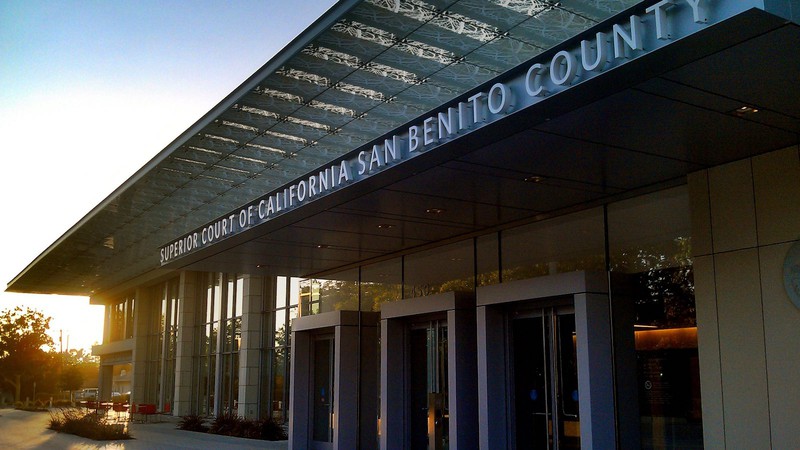
San Benito County's Superior Court system is contained in a single courthouse. Michael Patrick / Wikimedia Commons Creative Commons Attribution-Share Alike 4.0 International License
At approximately 59,000 people, San Benito County ranks as the 17th smallest of California's 58 counties, and easily the smallest in the greater Bay Area region. As a result, the county also has the smallest court system in the area with just one courthouse handling all cases and legal matters. Situated at 450 4th Street in the Central Coast city of Hollister, about 45 miles south of San Jose, the County Courthouse is also among the newest in the area, with construction completed just six years ago.
Inside that very courthouse is where most San Benito County residents will have their first face-to-face encounter with one of the three branches of government. Let's face it, the president, the governor, Congress and even state legislators can seem distant and sometimes, unless you stop to really give them some thought, irrelevant to our daily lives.
Not so with the judicial branch. Decisions by judges and the workings of the court system affect everyday life in startlingly direct ways. In extreme cases, they can take away your freedom, if you are unfortunate enough to be convicted of a crime. But the courts affect us in more mundane ways as well. Traffic tickets. Divorces. Business disputes. Dividing up the estates of deceased loved ones. All of those matters and many more in San Benito County are decided behind the doors of that two-story concrete and glass building at the corner of 4th and Monterey.
Each county has its own Superior Court system in California. Counties previously maintained separate Municipal Court systems as well, but between 1998 — when voters passed Prop 220—and 2001, the systems merged throughout the state leaving just one court system per county. Which seems like plenty.
Municipal courts generally heard misdemeanor cases, traffic violations and other minor matters. But frequently, cases needed to be upgraded from municipal courts to their superior counterparts. And that created what became a heavy burden of paperwork. The merger was somewhat controversial at the time, with critics worrying that municipal court judges lacked the training and qualifications to handle felonies, which had previously been the domain of Superior Court jurists.
But two decades on from the demise of California’s municipal court system, all judges are now superior court qualified and, at least in theory, should be able to adjudicate any level of case from DUI charges right up through first-degree murder.
Until January of 2021, the judge in charge in San Benito, which generally keeps just two judges and a commissioner on assignment in the Hollister facility’s three courtrooms, was Presiding Judge Steven T. Sanders, who was elected to the bench in 2000. In 2018, he won his fourth six-year term, running unopposed. But in December of 2020, he announced that he would retire as of January 15.
The other judge on duty at the county courthouse, J. Omar Rodriguez, won his seat in the 2018 election at the age of 37, defeating two other candidates. He won the seat vacated by retiring Judge Harry Tobias, who sat on the San Benito Superior Court bench for 24 years. When Sanders retired, Rodriguez became the presiding judge of San Benito County. In fact, as of June, Rodriguez was the only judge in the county. Governor Gavin Newsom had yet to name Sanders' replacement on the bench.
Rodriguez, a native of Hollister and former San Benito County prosecutor, currently oversees all civil, family law, probate and juvenile cases for San Benito County. Sanders handled criminal matters, as well as traffic and juvenile dependency cases.
The newest judge told the local news site BenitoLink that he hopes to push the court to adopt more online access to cases and court resources. Currently, most forms necessary to start a variety of legal proceedings may be downloaded online But they must be filed in person at the courthouse, between 8 a.m. and 4 p.m., Monday through Friday.
Pandemic Precautions
As it has throughout California, 2020 has been a difficult year for the San Benito Superior Court. Like all courthouses in the state, the Hollister facility largely shut down on March 23 due to the ongoing coronavirus pandemic.
On June 9, 2020, as the state continued its phased reopening process, Sanders signed an order allowing the courthouse to open up on a limited basis. Entrants to the courthouse were subjected to health measures, including temperature checks, before they were allowed inside.
Long form articles which explain how something works, or provide context or background information about a current issue or topic.